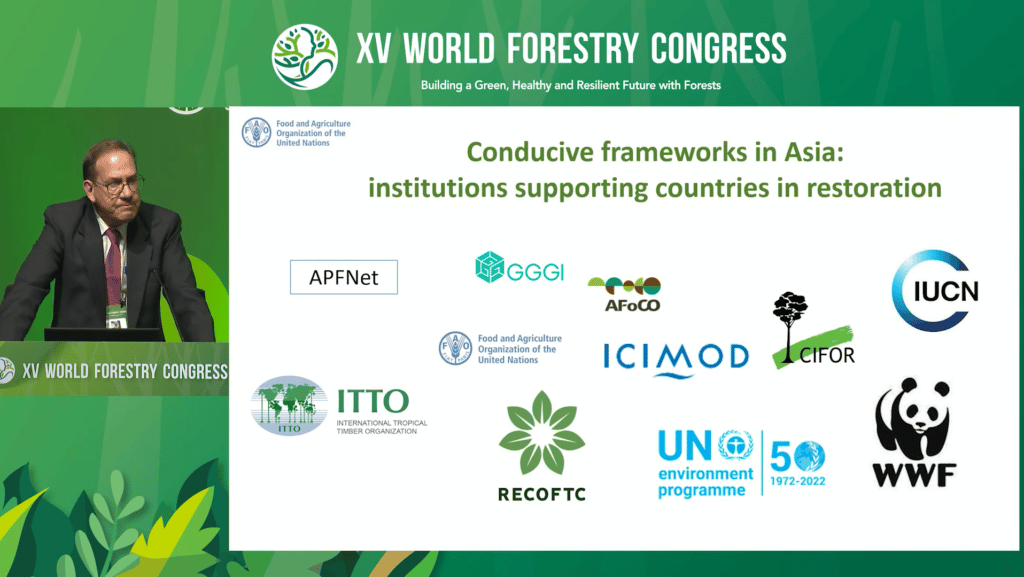The Landscape Partnership Asia was officially launched, attracting high levels of interest from around the world.
May 2, 2022 — His Excellency (former) Minister of Korea Forest Service Choi Byeong Am officially launched the Landscape Partnership Asia on Monday 2 May 2022 at the XV World Forestry Congress in Seoul, Republic of Korea.
‘Drylands and drought-prone areas are not only ecosystems but also home to 2.5 billion people,’ he said. ‘Around 30% of the world’s drylands are located in Asia and most of them are in need of restoration. This is not impossible to achieve. The Republic of Korea restored its forests despite hard times. When our reforestation activities started, the GDP per capita of Korea was not even USD 500. After the Korean War, from 1973 until 1987, we have planted over 10 billion trees. Without technology and resources, we achieved success only due to people’s willingness to participate, without distinction between women or men. Currently, countries in Asia have better conditions than Korea at that time so I strongly believe that if you have the willingness, you can do it.
‘The launch of the Landscape Partnership Asia comes at very much the right time. The Republic of Korea, as a member of the AFoCO, will put all its effort into positively and actively supporting the Landscape Partnership Asia. AFoCO is already acting as the Partnership’s Secretariat.’


Ricardo Calderon, executive director of AFoCO, emphasised that the Partnership was an ‘Evolving, multi-stakeholder platform that seeks to implement performance-based investments in restoring Asian drylands and drought-prone areas. The partners range from public through private to civil society. It will seek commitments and funding from implementing, technical, financial and political partners.’
The Partnership — which was co-founded by AFoCO, the Center for International Forestry Research and World Agroforestry (CIFOR-ICRAF) and the Global EverGreening Alliance — plans to realise by 2032 that national dryland restoration efforts are substantially enhanced with large areas brought under integrated dryland and drought management.
‘We are aiming for a minimum of 10 million hectares,’ he said. ‘Training and capacity building at various levels will be the backbone and project goals will align with national and international commitments that will be quantified based on investment and impact. AFoCO, a formal intergovernmental body, is committed to providing the bridge in order to enhance cross-sectoral cooperation, broaden coordination and coherence of the sustainable management of forests.’
Robert Nasi, managing director of CIFOR-ICRAF, noted that ‘drylands have been largely neglected so far by the restoration or climate agendas. Yet they harbour large amounts of unique biodiversity and of carbon thanks to their sheer size. Asian drylands have been even more neglected than other drylands. Dryland resources for crops, wood products or grazing are essential to the livelihoods of millions yet are among the most degraded and mis-managed lands. This makes the Landscape Partnership Asia totally relevant and more than timely. We still have time to turn the tide but not much.’
Paola Agostini, lead natural resources specialist, World Bank, provided technical insight into some of the issues facing the region. Photographs of Tashkent in Uzbekistan taken during its first dust storm ever, in late 2021, dramatically highlighted the impact of degraded drylands on human wellbeing.
‘In the mountains, rivers of mud from erosion flow during heavy rains,’ added Agostini. ‘All these disasters have huge economic impact. Every year, from the Aral seabed alone, sand and dust storms generate losses of over USD 44 million, including health impact and crop losses averaging USD 11.6 million per year. Continuing practices will result in loss of benefits averaging USD 32.6 million per year. Landscape degradation costs the regional Central Asian economy at least 4% of gross domestic product.’
The Bank, with partners including the Korea Forest Service and the United Nations Economic Commission for Europe, is focusing on transboundary corridors, which are hotspots of degradation, said Agostini, such as through the Central Asia Resilient Landscape Restoration Programme in Kazakhstan, Kyrgyzstan, Tajikistan and Uzbekistan, focusing on fruit-and-nut agroforestry systems.
Chris Armitage, chief executive officer of the Global EverGreening Alliance, noted that restoration of at least 10 million hectares by 2030 was an ‘extremely heavy lift’ that will require a ‘truly collaborative effort to scale up existing initiatives’.
‘We can’t rely on grant funding alone to deal with this massive challenge,’ said Armitage. ‘Grants should be seen as catalytic funding used to unlock much larger investments from the private sector. For example, Climate Asset Management announced a USD 150 million investment at COP26 in the Alliance’s Restore Africa programme. As part of Landscape Partnership Asia, we are now also well along the way to a USD 150 million programme called Restore Southeast Asia, which will be revealed fully in the near future.’
Sam Lampert, investment director of Mirova, an investment management company committed to valuing, conserving and enhancing natural capital, said that the company focuses on how to shift the economy to a more sustainable model.
‘We see enormous value and potential in taking a landscape approach to think around how we can enhance restoration in Asia,’ he said. ‘We currently manage a Land Degradation Neutrality Fund, which is about USD 200 million, focused on how we can make supply chains sustainable and restoring land; and we have a number of incubation funds focusing on the carbon markets. We are very, very optimistic about this time where we see a huge perception around the private sector’s interest in investments and the potential for scale.’
Chris Dickinson, senior ecosystems and ecosystem services with the Division of Mitigation and Adaptation of the Green Climate Fund, said that the Fund is already supporting projects in Lao PDR, Bhutan, Kyrgyz Republic and Timor-Leste and will explore how partnerships can be undertaken with the private sector and the member countries of the Landscape Partnership Asia, particularly, for developing projects in Central Asia.
Eunsik Park, director general of the International Affairs Bureau of the Korea Forest Service, reinforced Minister Choi Byeong Am’s speech, emphasising that economic growth and environmental improvement can go together, based on Korea’s own experience.
‘As the Minister said,’ noted Park, ‘in the 1950s, the Republic of Korea was one of the world’s poorest countries. Yet through six national plans, the Republic of Korea achieved successful forest restoration and sustainable forest management. Evaluation of the benefits by the Institute of Forest Science in 2018 found a total value provided by forests per year of USD 221 billion, amounting to 11.7% GDP or USD 4,280 per capita.’

Thomas Hofer, senior forestry officer and team leader of Forests Resources Management of the Forestry Division, Food and Agriculture Organization of the United Nations noted that restoration happens on the ground at national level, which is why national commitment is essential.
‘Restoration also requires collaboration across sectors at national level, overcoming administrative boundaries,’ he said. ‘Restoration needs to be prioritised in national strategies, programmes and budgets and national collaboration needs to also cross borders, exchanging experience and knowledge, which is a part of the Landscape Partnership Asia and also the United Nations Decade on Ecosystem Restoration and the Regional Strategy and Action Plan for Forest and Landscape Restoration in Asia-Pacific of the Asia-Pacific Forestry Commission.’ Four hundred million hectares are available for restoration in Asia-Pacific, he noted.
Dipayan Bhattacharyya, senior programme advisor of the United Nations World Food Programme, said that ‘food production is possibly the biggest threat to Nature: it causes 70% of the loss of biodiversity; 75% of deforestation; and consumes 70% of the world’s water resources’.
The Programme has been working with various partners to rehabilitate more than 800,000 hectares of degraded land. In Asia, the Programme works in Afghanistan, Bangladesh, Kyrgyz Republic and the Philippines.

His Excellency Dzhanybekov Askarbek, Minister of Agriculture, Water Resources and Regional Development of the Kyrgyz Republic noted that ‘approximately 2.4 million people live near forests and largely depend on them’ in the country.
‘The growing dependence of the rural population on fuelwood and the increasing demand for timber exceed sustainable levels,’ he said. ‘About 12.5% of forests suffer degradation and are exposed to high pressure. Pastures cover 9.2 million hectares and are important sources of income, with about 3.5 million residents or more than 60% of the population dependent on livestock grown on pastures in extensive grazing systems yet almost half of the pastures are degraded. In the new development programme, 2022–2026, the Kyrgyz Republic has declared the desire to preserve and restore mountain forest ecosystems.’
Her Excellency Aliya Shalabekova, vice-minister of Ecology, Geology and Natural Resources, Republic of Kazakhstan, emphasised the tragedy of the Aral Sea, which is ‘now not just a local problem but also a global one’.
Once the fourth-largest largest lake in the world, it has now been so reduced owing to diversion of water for Soviet Era irrigation projects that only a tiny part of the lake remains.
‘The main focus for the former seabed now is to decrease the area of salt desert,’ said Shalabekova. ‘We are planting “saxual” [Haloxylon ammodendron] to the extent of 1 million hectares. We strongly support the launch of the Landscape Partnership Asia. Kazakhstan is eager to participate in all activities to plant trees and we hope that this will be for the well-being of all citizens in Kazakhstan and in the region because this is more than a local tragedy. We hope that by the next Congress we can show the results of our activities.’
Watch the launch video
Grand Launch of the Landscape Partnership Asia during the XV World Forestry Congress
Contributed by Rob Finlayson, Senior Associate Fellow at World Agroforestry (ICRAF)

